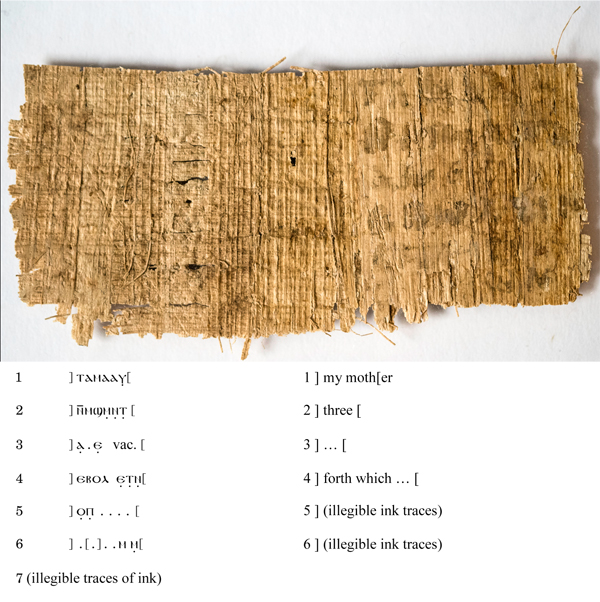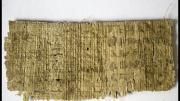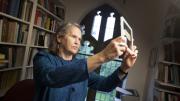At 7 p.m. this evening in Rome (1 p.m. EST), Hollis professor of divinity Karen L. King revealed to a conference of Coptic scholars the existence of a newly discovered Christian gospel. In the fragmentary text, Jesus refers unmistakably to “my wife.”
Written on a piece of papyrus now reduced to just four centimeters high and eight wide, the fragment addresses issues of family and discipleship. “This is the only extant ancient text which explicitly portrays Jesus as referring to a wife,” King writes in her scholarly paper on the “The Gospel of Jesus’s Wife,” which she presented at the Tenth International Congress of Coptic Studies. The session took place across the street from the Vatican at the Institutum Patristicum Augustinianum, a research center within the faculty of theology at the Pontifical Lateran University (known as the Pope’s University).
The paper will appear in the January 2013 issue of the Harvard Theological Review. In an interview, King emphasized that this new discovery does not prove that the historical Jesus was married. This gospel, like others dated to the second century which make opposing claims—that Jesus was celibate, for example—are too late, historically speaking, to provide any evidence as to whether the historical Jesus was married or not, she says. But the fragment does suggest that 150 years or so after Jesus’s birth, Christians were already taking positions on such questions. Significantly, this new text pushes the date at which some Christians were asserting that Jesus was married back to a time contemporaneous with the earliest assertions that he was celibate.
Papyrus is extremely durable under dry desert conditions. This particular fragment dates to the fourth century, but is almost certainly a copy of an earlier text that probably originated around A.D. 150, King says. Written in a form of Coptic known as Sahidic, a language of Upper Egypt, the fragment is owned by a collector of Greek, Arabic, and Coptic papyri who first wrote to King after reading her book, The Gospel of Mary of Magdala: Jesus and the First Woman Apostle.
“I was contacted in 2010 by the owner, who didn’t read Coptic,” King recalls. After she agreed to translate the text, the collector sent a photograph and indicated that the fragment “might have something to do with Jesus being married.” King remembers being immediately suspicious. Blank pieces of ancient papyrus are not difficult to come by on the antiquities market, she explains, and in the low resolution photographs she was seeing, the writing could easily have been the work of a forger. “I was very busy with other things and said I am not going to be able to work on this,” she says.
The owner e-mailed again in 2011 and asked her a second time if she would examine the fragment. Looking again at the text, King found “what looked like a connection to the [noncanonical] Gospel of Thomas. And [the fragment] looked as if it might have comparative value to the Gospel of Mary.” She told the owner she needed the actual document so it could be authenticated by experts.
In December 2011, he hand-carried the papyrus, sandwiched between two pieces of glass, to the Divinity School, where King was able to examine it in person for the first time. Although King teaches Coptic and is an historian of early Christianity, she noted in an interview that she is not a papyrologist nor a Coptic linguist. She therefore sought expert opinions about the fragment before proceeding with her own analysis. This March, still thinking that the fragment was likely a forgery, she carried it in her purse to New York City where she and AnneMarie Luijendijk Th.D. ’05, a papyrologist and scholar of the New Testament and Early Christianity at Princeton who contributed to the paper, met with Roger Bagnall, director of the Institute for the Study of the Ancient World (ISAW) at New York University, and one of the world’s two or three leading papyrologists. She and Luijendijk left Bagnall’s office believing the fragment was real. Rather than taking the subway as she had planned, they hailed a taxi. (“The fragment deserves a cab,” she recalls thinking.)
Close examination had shown that the papyrus was originally created as though it would be used in a scroll. The “joint” or kollêsis between two sheets of papyrus is clearly visible. But the writing on both the front and back of the fragment indicated that it was part of a codex, an early form of book. In the fourth century, scrolls were being made in the traditional way and then cut into sheets like modern pages so that they could be stitched together in book form. Furthermore, a hole in the papyrus where an insect had gnawed it after the ink had been laid strengthened the case for the fragment’s authenticity, as did the presence of ink on damaged, dangling strands of papyrus fibers at the edge of the fragment. “This is almost impossible for a forger to recreate,” says King.
King also sought the expert opinion of Ariel Shisha-Halevy, an expert in Coptic linguistics at Hebrew University, who wrote that he believes on the basis of language and grammar that the text is authentic: “That is to say, all of its noteworthy grammatical features either separately or conjointly do not warrant condemning it as a forgery.”
The letter forms, however, are inconsistent. This is not “the hand of a well-trained literary scribe,” King acknowledges. “Our best explanation for this is that the scribe has a nubby pen from which the ink doesn’t flow consistently.” Because the process of dating the ink itself would destroy it, King is arranging to have its chemical compostion tested to see whether it is consistent with inks used in antiquity. Asked why she would reveal the existence of the text before the ink could be tested, King said that so many people had come to know about the fragment, she grew concerned about misleading news leaks—specifically, headlines claiming the text proved Jesus had a wife, when instead it is evidence that some early Christians believed Jesus had a wife.
She also wants to make the fragment available to qualified colleagues so that it can be rigorously examined. “From an academic point of view this is absolutely critical,” she says. “This is why we are going ahead with this: copies of the letters, high-quality photographs, access for scholars.” “Academia,” she notes, “is always a process.” But “at this point,” she adds, “I am inclined to believe that [the fragment] is genuine. We had such a strong argument for its being a forgery, that once we could address all the questions, it increased my confidence in its authenticity.”
King is not the first scholar to set eyes on the fragment. Its previous owner, a collector in Berlin named H. U. Laukamp, had brought it to the attention of Egyptologist Peter Munro (1930-2008) at the Free University of Berlin, who had in turn shown it to Professor Gerhard Fecht (now deceased), who believed it to be “the sole example of a text in which Jesus uses direct speech with reference to having a wife. Fecht is of the opinion that this could be evidence for a possible marriage,” read a note dated 1982, written in English, that accompanied the fragment, the prior provenance of which is unknown.

Photograph © Karen L. King, 2012
This papyrus fragment of the Gospel of Jesus's Wife dates to the fourth century. Written in Sahidic, a language of Upper Egypt, it was probably translated from an earlier Greek text dating to the middle of the second century, says Hollis professor of divinity Karen L. King. Because there is writing on both the front and back of the papyrus fragment, it was not part of a scroll, but rather a codex, an early form of a book. Eight legible lines on the front have been translated into English.
King’s own analysis is concerned with interpretation, which is extremely difficult due to the fragmentary nature of the text. The first line reads, “My mother gave to me,” and what follows is probably the word “life.” Line two reads “the disciples said to Jesus.” The third line reads “deny. Mary is worthy of it.” It is the fourth line, “Jesus said to them, ‘My wife,’” that is most clear. “Those words can mean nothing else,” says King. Line five reads “She will be able to be my disciple,” but it is unclear whether Jesus is referring to Mary, to his wife, or to someone else.

Photograph © Karen L. King, 2012
Although the back appears blank, infrared photography revealed several words including "my moth[er]" and "three."
King believes that the author of this early Christian text believed that Mary of Magdala, one of Jesus’s disciples, was his wife. Although she disagrees with that assertion—based on the fact that women were almost always referred to by their relationship to men (as in “Mary, wife of Joseph”), and no such early reference to Mary of Magdala as Jesus’s wife exists—that by itself neither proves nor disproves whether Jesus was married. “All of the earliest and most reliable information about the historical Jesus is silent” on this question.
Whether the discovery will have any impact within the Catholic Church, whose tradition of celibacy among the priesthood is based in part on the belief that Jesus himself was celibate, remains to be seen. But the fragment has changed King’s own readings of other early Christian texts, particularly the noncanonical Gospels of Mary and of Philip. Those texts make reference to relations between the sexes that she had previously read in an allegorical or spiritual sense. The Gospel of Jesus’s Wife has made her start to rethink those earlier interpretations. And she suspects that the discovery will have a greater impact than the 2006 publication of the Gospel of Judas (which said that Jesus had ordered Judas’s betrayal), because the Gospel of Jesus’s Wife has more relevance to contemporary discussions taking place within churches today.
King has posted a draft of the paper, an extensive question-and-answer on the fragment and its meaning, and images of it, on a page on the Divinity School website. See also the official press release.












